INSTITUT SUPERIEUR D'ANTHROPOLOGIE
INSTITUT OF ANTHROPOLOGY
COURS ONLINE – COURS A DISTANCE
INSCRIPTIONS OUVERTES
REGISTER NOW
TURQUIE – 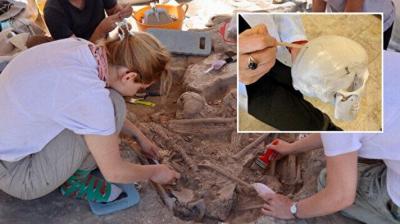 Çatalhöyük - Traces of trepanation (skull drilling operation) were found on a skull found in the 9,000-year-old Çatalhöyük, near the modern city of Konya in central Turkey. Millennia before the rise of Mesopotamian cities to the south, the proto-city Çatalhöyük thrived in central Anatolia. Sprawled over 34 acres and home to as many as 8,000 people, it was the metropolis of its day. People lived in this community continuously for almost 2,000 years. In their statement to the Anadolu Agency (AA), archaeologists said that they came across an interesting grave containing 7 individuals during the excavations last year. During the studies carried out on human skeletons excavated on the floor of a house, a hole with a diameter of 2.5 centimeters was found on the skull bones of a young male individual. Çatalhöyük Excavation head and Anadolu University Faculty Member Associate Professor Ali Umut Türkcan said in his statement; “There has been a settlement throughout 16 stratifications. It is a unique region in the world. It is a settlement where the culture progressed very slowly and was abandoned. Our work continues especially in the neighborhood we found on the long street next to the exhibition area, which we call ‘northern Korugan’. We opened a new area towards the slope of the settlement. While opening that area, we found the second neighborhood. We identified a large building in the new area. We concentrated the work on the building of approximately 80 square meters, with 5 chambers. Last year, we came across a grave covered with a vulture’s claw in a house here. The anthropologists of the excavation made detailed examinations of the grave containing 7 individuals. A young man “The drilling process in the individual’s skull caught our attention. In Çatalhöyük, we saw a clear example of trepanation for the first time.” Anadolu University Archeology Department faculty member Professor Handan Üstündağ, a member of the anthropology team of the excavation, said: “A round piece of bone was removed from the side of the skull through a circular incision about 2.5 centimeters in diameter. We found many incision marks indicating that they had grazed the scalp during this process. We think this was a trepanation for therapeutic purposes. We identified this skeleton as belonging to a young male aged 18-19. There is no indication that the individual lived after this operation. Because there was no sign of healing in the bone tissue. When this operation was performed, this person was either dying or already dead.”Üstündağ stated that the practice of trepanation is known to have been used in the past for medical treatment and that trepanation is a method used in the treatment of headaches, brain hemorrhage, cleaning of broken bone fragments and blood after head trauma, fluid accumulation in the brain, and mental disorders.
Çatalhöyük - Traces of trepanation (skull drilling operation) were found on a skull found in the 9,000-year-old Çatalhöyük, near the modern city of Konya in central Turkey. Millennia before the rise of Mesopotamian cities to the south, the proto-city Çatalhöyük thrived in central Anatolia. Sprawled over 34 acres and home to as many as 8,000 people, it was the metropolis of its day. People lived in this community continuously for almost 2,000 years. In their statement to the Anadolu Agency (AA), archaeologists said that they came across an interesting grave containing 7 individuals during the excavations last year. During the studies carried out on human skeletons excavated on the floor of a house, a hole with a diameter of 2.5 centimeters was found on the skull bones of a young male individual. Çatalhöyük Excavation head and Anadolu University Faculty Member Associate Professor Ali Umut Türkcan said in his statement; “There has been a settlement throughout 16 stratifications. It is a unique region in the world. It is a settlement where the culture progressed very slowly and was abandoned. Our work continues especially in the neighborhood we found on the long street next to the exhibition area, which we call ‘northern Korugan’. We opened a new area towards the slope of the settlement. While opening that area, we found the second neighborhood. We identified a large building in the new area. We concentrated the work on the building of approximately 80 square meters, with 5 chambers. Last year, we came across a grave covered with a vulture’s claw in a house here. The anthropologists of the excavation made detailed examinations of the grave containing 7 individuals. A young man “The drilling process in the individual’s skull caught our attention. In Çatalhöyük, we saw a clear example of trepanation for the first time.” Anadolu University Archeology Department faculty member Professor Handan Üstündağ, a member of the anthropology team of the excavation, said: “A round piece of bone was removed from the side of the skull through a circular incision about 2.5 centimeters in diameter. We found many incision marks indicating that they had grazed the scalp during this process. We think this was a trepanation for therapeutic purposes. We identified this skeleton as belonging to a young male aged 18-19. There is no indication that the individual lived after this operation. Because there was no sign of healing in the bone tissue. When this operation was performed, this person was either dying or already dead.”Üstündağ stated that the practice of trepanation is known to have been used in the past for medical treatment and that trepanation is a method used in the treatment of headaches, brain hemorrhage, cleaning of broken bone fragments and blood after head trauma, fluid accumulation in the brain, and mental disorders.
An 8,500-year-old trepanned skull discovered in Çatalhöyük - Arkeonews
ITALIE-  Pompéi - An important marble relief depicting the earthquake of 62 AD, stolen from the ruins of ancient Pompeii in Italy in 1975, was found in a family home in the quiet village of Herzele in Belgium’s East Flanders region. For 50 years, the ancient marble artifact has been installed in a wall lining the staircase leading down to the basement. The homeowner’s son, Geert de Temmerman, explained that the mini monument had been brought back from Pompeii as a souvenir five decades ago. The marble relief sculpture, which dates from around 62 C.E., is a narrow strip depicting an earthquake that occurred that same year. Most notably, it depicts the Pompeii gates collapsing. The marble relief had been stolen on July 14th, 1975, from the house of banker L. Caecilius Iucundus where it originally hung above the atrium altar.
Pompéi - An important marble relief depicting the earthquake of 62 AD, stolen from the ruins of ancient Pompeii in Italy in 1975, was found in a family home in the quiet village of Herzele in Belgium’s East Flanders region. For 50 years, the ancient marble artifact has been installed in a wall lining the staircase leading down to the basement. The homeowner’s son, Geert de Temmerman, explained that the mini monument had been brought back from Pompeii as a souvenir five decades ago. The marble relief sculpture, which dates from around 62 C.E., is a narrow strip depicting an earthquake that occurred that same year. Most notably, it depicts the Pompeii gates collapsing. The marble relief had been stolen on July 14th, 1975, from the house of banker L. Caecilius Iucundus where it originally hung above the atrium altar.
2000-year-old Genuine Pompeii marble relief installed in a wall lining the staircase leading down to the basement in a Belgium home - Arkeonews
ITALIE – 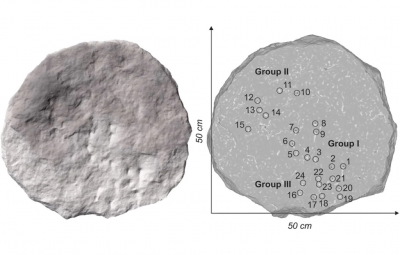 Castelliere di Rupinpiccolo - Two circular stones measuring 50 centimeters in diameter have been discovered in Castelliere di Rupinpiccolo, an ancient hilltop fortress in the Italian province of Trieste, and one of them may be one of the oldest celestial map found in Italy. The discovery was announced in a press release by the Italian National Institute for Astrophysics (INAF). Castelliere di Rupinpiccolo is a defensive structure. Used as a fortification from an era between 1800 and 1650 BC. until 400 BC, that of Rupinpiccolo is one of the most important castles, as well as the first brought to light. Two large circular stones – two thick discs about 50 cm in diameter and 30 cm deep – were found near the entrance to the Castelliere and attracted the attention of archaeologists. One of the stones, according to Paolo Molaro of INAF and researchers from Ca’ Foscari University of Venice and ICTP, is a representation of the sun, while the other is a carved celestial map dating from the 4th century BC. The German astronomy journal Astronomische Nachrichten published a study about the stones, in which the study’s authors said the celestial map shows the sky above Rupinpiccolo some 2,500 years ago, making the discovery the oldest known One of the celestial maps laid out in Italy. “I was contacted by Federico Bernardini, whom I didn’t know, telling me that he needed an astronomer”, Molaro said to Media Inaf, “because he seemed to have identified the constellation of Scorpio in a stone from the Carso. My first reaction was incredulity, given that the southern part of Scorpio is just above the horizon in our latitudes. But then, discovering that the precession of the equinoxes raised it by about 10-12 degrees and the impressive coincidence with the constellation, I began to delve deeper into the question… So I identified Orion, the Pleiades, and, in the back, Cassiopeia. All points present except one.” 29 engravings on the stone have been identified by the team, and they perfectly match the constellations of Cassiopeia, Orion, Scorpius, and the Pleiades. The researchers hypothesize that the carvings were probably created by the same person using a hammer and a crude metal chisel with a 6-7 mm tip based on the angle of the cut marks in the stone. The researchers also used the program Stellarium to simulate the night sky because a star called Theta Scorpii was so low on the horizon in the 1800s BCE that it cannot be seen today. But let’s get to the 29 signs. All but one are superimposable on the stars of Scorpius, Orion, the Pleiades and probably – also considering the 5 signs on the back of the stone – Cassiopeia. And it is an overlap with very high statistical significance, the authors specify: the p-value is much lower than 0.001. In other words, it is highly unlikely that the arrangement of those signs was purely the result of chance. Not only that: the deviations from the true positions are of the order of the size of the signs, demonstrating considerable care in the execution. All except one, we said. But the 29th sign could also be there on purpose. The intruder could represent a supernova, the authors propose. Or a so-called “failed supernova”. So one of those objects that astronomers call transients: at a certain point they make their appearance, and then disappear again. If this were the case, researchers suggest, there could be a black hole there in that point of the sky today. The Nebra disk, a bronze artifact from Germany that dates to approximately 1600 BC and has gold applications to represent the Sun, Moon, and Pleiades, is likely the oldest known representation of the night sky. However, it’s more of a symbolic representation than a true map. We have to go back to the first century BC for “faithful” maps, during which time maps were most likely derived from the 135 BC Hypparcos catalog.
Castelliere di Rupinpiccolo - Two circular stones measuring 50 centimeters in diameter have been discovered in Castelliere di Rupinpiccolo, an ancient hilltop fortress in the Italian province of Trieste, and one of them may be one of the oldest celestial map found in Italy. The discovery was announced in a press release by the Italian National Institute for Astrophysics (INAF). Castelliere di Rupinpiccolo is a defensive structure. Used as a fortification from an era between 1800 and 1650 BC. until 400 BC, that of Rupinpiccolo is one of the most important castles, as well as the first brought to light. Two large circular stones – two thick discs about 50 cm in diameter and 30 cm deep – were found near the entrance to the Castelliere and attracted the attention of archaeologists. One of the stones, according to Paolo Molaro of INAF and researchers from Ca’ Foscari University of Venice and ICTP, is a representation of the sun, while the other is a carved celestial map dating from the 4th century BC. The German astronomy journal Astronomische Nachrichten published a study about the stones, in which the study’s authors said the celestial map shows the sky above Rupinpiccolo some 2,500 years ago, making the discovery the oldest known One of the celestial maps laid out in Italy. “I was contacted by Federico Bernardini, whom I didn’t know, telling me that he needed an astronomer”, Molaro said to Media Inaf, “because he seemed to have identified the constellation of Scorpio in a stone from the Carso. My first reaction was incredulity, given that the southern part of Scorpio is just above the horizon in our latitudes. But then, discovering that the precession of the equinoxes raised it by about 10-12 degrees and the impressive coincidence with the constellation, I began to delve deeper into the question… So I identified Orion, the Pleiades, and, in the back, Cassiopeia. All points present except one.” 29 engravings on the stone have been identified by the team, and they perfectly match the constellations of Cassiopeia, Orion, Scorpius, and the Pleiades. The researchers hypothesize that the carvings were probably created by the same person using a hammer and a crude metal chisel with a 6-7 mm tip based on the angle of the cut marks in the stone. The researchers also used the program Stellarium to simulate the night sky because a star called Theta Scorpii was so low on the horizon in the 1800s BCE that it cannot be seen today. But let’s get to the 29 signs. All but one are superimposable on the stars of Scorpius, Orion, the Pleiades and probably – also considering the 5 signs on the back of the stone – Cassiopeia. And it is an overlap with very high statistical significance, the authors specify: the p-value is much lower than 0.001. In other words, it is highly unlikely that the arrangement of those signs was purely the result of chance. Not only that: the deviations from the true positions are of the order of the size of the signs, demonstrating considerable care in the execution. All except one, we said. But the 29th sign could also be there on purpose. The intruder could represent a supernova, the authors propose. Or a so-called “failed supernova”. So one of those objects that astronomers call transients: at a certain point they make their appearance, and then disappear again. If this were the case, researchers suggest, there could be a black hole there in that point of the sky today. The Nebra disk, a bronze artifact from Germany that dates to approximately 1600 BC and has gold applications to represent the Sun, Moon, and Pleiades, is likely the oldest known representation of the night sky. However, it’s more of a symbolic representation than a true map. We have to go back to the first century BC for “faithful” maps, during which time maps were most likely derived from the 135 BC Hypparcos catalog.
A 2,500-year-old celestial map carved on the surface of a circular stone found in Italy - Arkeonews
ITALIE –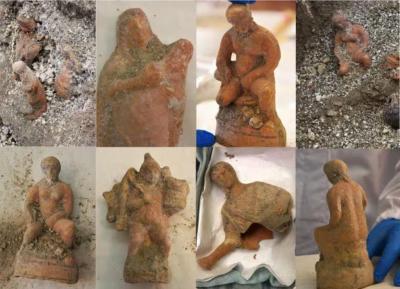
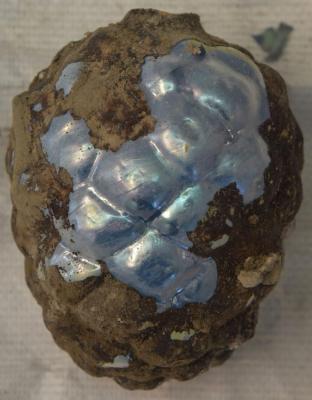 Pompéi - Archaeologists unearthed 13 terracotta figurines during recent excavations in the Domus adjacent to the “House of Leda and the Swan” along Via del Vesuvio in Pompeii. The 13 clay figurines, approximately 15 centimeters high, were associated with the cult of the goddess Cybele. According to archaeologists, the figurines may be associated with Kybele and Attis, telling the story of the mother goddess’s tragic love for a mortal. The miniature clay sculptures were found upright on a horizontal plane, probably on a shelf that once hung inside the home. Some statues were human figures, while others included a chicken head and a pine cone.
Pompéi - Archaeologists unearthed 13 terracotta figurines during recent excavations in the Domus adjacent to the “House of Leda and the Swan” along Via del Vesuvio in Pompeii. The 13 clay figurines, approximately 15 centimeters high, were associated with the cult of the goddess Cybele. According to archaeologists, the figurines may be associated with Kybele and Attis, telling the story of the mother goddess’s tragic love for a mortal. The miniature clay sculptures were found upright on a horizontal plane, probably on a shelf that once hung inside the home. Some statues were human figures, while others included a chicken head and a pine cone.
Terracotta Figurines of the ancient cult of the goddess Cybele discovered in Pompeii Domus - Arkeonews
EGYPTE – 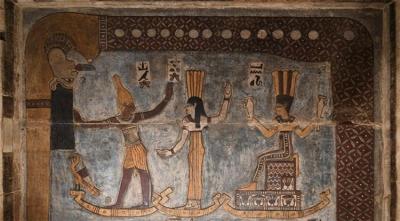 Esna - For a team of archeologists in Egypt, the last five years have been a cleaning mission. The group have been scrubbing dirt, soot, and bird droppings off the Temple of Esna's ceiling to reveal incredible ink inscriptions which were previously murky. Among these are a stunning New Year's scene of Egyptian gods—Orion, Sirius, and Anukis—onboard boats under the sky god. The Temple of Esna is south of Luxor in Egypt. The part which remains standing is the vestibule or pronaos, which was built during the Roman period under Emperor Claudius (41–54 CE). Made of sandstone, it is 37 meters (88.6 feet) long, 20 meters wide (65.6 feet), and 15 meters (49.2 feet) high. It is unknown exactly what deity the temple was dedicated to but further cleaning of the walls may suggest an answer. Answers may be slow however, as it took the 30-person team five years to uncover the ceiling. According to a statement from the University of Tübingen, which partners with the Egyptian Ministry of Tourism and Antiquities on the project, the soot has receded across “hundreds of figures and astronomical representations, revealing them once more in their original colors.” The ceiling has seven thematic sections. Among the panels is a New Year's scene, where Sothis, aka Sirius, is depicted by Orion. “Sirius is invisible in the night sky for 70 days a year until it rises again in the east,” Professor Christian Leitz of University of Tübingen explained. “That point was New Year's Day in ancient Egypt and also heralded the annual flooding of the Nile.” The goddess Anukis, also depicted, caused the Nile floodwaters to retreat about 100 days after this event. Also rendered on the ceiling were other figures, including a god with four rams' heads and a “representation of the south wind as a lion with four wings and a ram's head.”
Esna - For a team of archeologists in Egypt, the last five years have been a cleaning mission. The group have been scrubbing dirt, soot, and bird droppings off the Temple of Esna's ceiling to reveal incredible ink inscriptions which were previously murky. Among these are a stunning New Year's scene of Egyptian gods—Orion, Sirius, and Anukis—onboard boats under the sky god. The Temple of Esna is south of Luxor in Egypt. The part which remains standing is the vestibule or pronaos, which was built during the Roman period under Emperor Claudius (41–54 CE). Made of sandstone, it is 37 meters (88.6 feet) long, 20 meters wide (65.6 feet), and 15 meters (49.2 feet) high. It is unknown exactly what deity the temple was dedicated to but further cleaning of the walls may suggest an answer. Answers may be slow however, as it took the 30-person team five years to uncover the ceiling. According to a statement from the University of Tübingen, which partners with the Egyptian Ministry of Tourism and Antiquities on the project, the soot has receded across “hundreds of figures and astronomical representations, revealing them once more in their original colors.” The ceiling has seven thematic sections. Among the panels is a New Year's scene, where Sothis, aka Sirius, is depicted by Orion. “Sirius is invisible in the night sky for 70 days a year until it rises again in the east,” Professor Christian Leitz of University of Tübingen explained. “That point was New Year's Day in ancient Egypt and also heralded the annual flooding of the Nile.” The goddess Anukis, also depicted, caused the Nile floodwaters to retreat about 100 days after this event. Also rendered on the ceiling were other figures, including a god with four rams' heads and a “representation of the south wind as a lion with four wings and a ram's head.”
Explore Restored Paintings From an Ancient Egyptian Temple (mymodernmet.com)
CHINE – 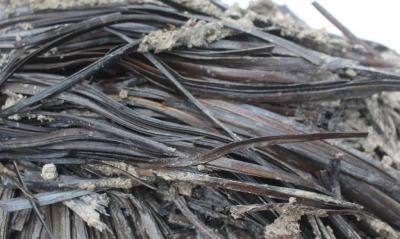 Qinjiazui - Archaeologists excavating a tomb in the Qinjiazui archaeological site of Jingzhou City, Hubei Province, China, have found the earliest multiplication formulas on record. The earliest multiplication formulas on record have been discovered on bamboo slips from the Warring States period (475BC-221BC), pushing the history of these formulas back by nearly a century, China’s National Cultural Heritage Administration (NCHA) announced at a press conference. The formula, which dates back to the 4th century BC during the Warring State Period (475-221 BC), precedes another piece discovered in central Hunan Province by approximately a century, said Yang Kaiyong, a research fellow at the Jingzhou Museum. The burial – known simply as M1093 – probably dates back to the reign of either King Chu Xuan or King Chu Wei, from 369 to 329 BCE. Bamboo slips were the most popular writing material in the period before paper became widespread. These slips, which are typically a centimeter or two wide and a few inches long, have been discovered in large numbers at the Qinjiazui site. Of all the tombs identified so far, M1093 contains the highest number of these slips. Thousands of bamboo slips holding over 30,000 characters ranging from mathematics, literature, and animal husbandry to medicines have been discovered in the tomb. Scientists have used infrared scanning to reveal the words on the slip: “Five times seven is thirty plus five, four times seven is twenty plus eight, three times seven is twenty plus one.” On one of the strips, researchers found multiplication formulas as well as the oldest known example of an algebraic table known as Jiujiushu. According to the researchers: “This significant discovery offers invaluable new resources for studying the history, culture, and ideologies prevalent during the pre-Qin period.” The Warring States period lasted from 475 to 221 BCE and ended when the Qin state overcame its six adversaries. This resulted in the unification of the Chinese empire for the first time and the establishment of the Qin dynasty.
Qinjiazui - Archaeologists excavating a tomb in the Qinjiazui archaeological site of Jingzhou City, Hubei Province, China, have found the earliest multiplication formulas on record. The earliest multiplication formulas on record have been discovered on bamboo slips from the Warring States period (475BC-221BC), pushing the history of these formulas back by nearly a century, China’s National Cultural Heritage Administration (NCHA) announced at a press conference. The formula, which dates back to the 4th century BC during the Warring State Period (475-221 BC), precedes another piece discovered in central Hunan Province by approximately a century, said Yang Kaiyong, a research fellow at the Jingzhou Museum. The burial – known simply as M1093 – probably dates back to the reign of either King Chu Xuan or King Chu Wei, from 369 to 329 BCE. Bamboo slips were the most popular writing material in the period before paper became widespread. These slips, which are typically a centimeter or two wide and a few inches long, have been discovered in large numbers at the Qinjiazui site. Of all the tombs identified so far, M1093 contains the highest number of these slips. Thousands of bamboo slips holding over 30,000 characters ranging from mathematics, literature, and animal husbandry to medicines have been discovered in the tomb. Scientists have used infrared scanning to reveal the words on the slip: “Five times seven is thirty plus five, four times seven is twenty plus eight, three times seven is twenty plus one.” On one of the strips, researchers found multiplication formulas as well as the oldest known example of an algebraic table known as Jiujiushu. According to the researchers: “This significant discovery offers invaluable new resources for studying the history, culture, and ideologies prevalent during the pre-Qin period.” The Warring States period lasted from 475 to 221 BCE and ended when the Qin state overcame its six adversaries. This resulted in the unification of the Chinese empire for the first time and the establishment of the Qin dynasty.
Earliest Multiplication Formulas Discovered in a 2,300-Year-Old Chinese Tomb - Arkeonews
MEXIQUE – 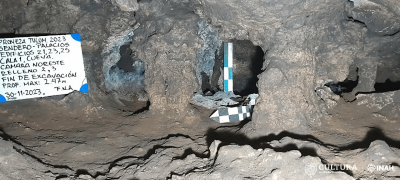 Tulum - Archaeologists from the National Institute of Anthropology and History (INAH) have discovered a hidden Maya burial chamber concealed within a cave at the archaeological complex in Tulum, Quintana Roo. The discovery, sealed off by a massive rock deep inside Mexico’s walled city of Tulum, offers a rare glimpse into the funerary practices of this pre-Hispanic civilization. By removing a large rock blocking the entrance to a hidden cave within the walled area of the Maya city, archaeologists uncovered the skeletal remains of several individuals. The discovery was made during routine clearing work for a new visitor path, which is nestled between two prominent temples. A meticulously glued sea snail hinted at Maya craftsmanship, while a split human skeleton hinted at a deeper secret. Upon removing the rock that sealed the entrance to the cavity, it was observed that it was literally splitting the skeletal remains of an individual, leaving the lower part of their body outside and the upper part inside. This would indicate that the person might have become trapped while attempting to access the cavity. Inside the cramped cave, barely taller than half a meter, lay eight adult burials remarkably preserved by the cool, dry environment. All materials are being studied further at INAH’s Quintana Roo Center by the head of the Department of Physical Anthropology, Allan Ortega Muñoz. As the exploration of the cave progressed, The coordinator of the archaeological research project, José Antonio Reyes Solís said, it was identified that the topography shows at least two small chambers, located in the southern and northern parts, no more than 3 meters long by 2 meters wide, and an average height of 50 centimeters. Likewise, a large number of skeletal remains of animals associated with the burials were recorded. According to the specialists in fauna identification, who collaborate on the project, Jerónimo Avilés and Cristian Sánchez, they correspond, in a preliminary manner, to various mammals (domestic dogs, mice, opossum, blood-sucking bats, white-tailed deer, tepezcuintle, armadillo nine banded, tapir, peccary); birds of the order Galliforme, Passeriforme, Pelecaniforme, Piciforme and Charadriiforme; reptiles (loggerhead sea turtle, land turtle and iguana); fish (tiger shark, barracuda, grouper, drum fish, puffer fish, eagle ray); crustaceans (crab and cirripedians), mollusks (snail) and amphibians (frog). Some bones have cut marks and others have been worked as artifacts, like punches, needles, or fan handles, characteristic of the area. A single ceramic “molcajete” (grinding bowl) further pinpointed the burials to the late Postclassic period (1200-1550 AD). In three of the burials, a small mortar of the type decorated with incisions was discovered, and it has been intervened by a restorer for preservation.
Tulum - Archaeologists from the National Institute of Anthropology and History (INAH) have discovered a hidden Maya burial chamber concealed within a cave at the archaeological complex in Tulum, Quintana Roo. The discovery, sealed off by a massive rock deep inside Mexico’s walled city of Tulum, offers a rare glimpse into the funerary practices of this pre-Hispanic civilization. By removing a large rock blocking the entrance to a hidden cave within the walled area of the Maya city, archaeologists uncovered the skeletal remains of several individuals. The discovery was made during routine clearing work for a new visitor path, which is nestled between two prominent temples. A meticulously glued sea snail hinted at Maya craftsmanship, while a split human skeleton hinted at a deeper secret. Upon removing the rock that sealed the entrance to the cavity, it was observed that it was literally splitting the skeletal remains of an individual, leaving the lower part of their body outside and the upper part inside. This would indicate that the person might have become trapped while attempting to access the cavity. Inside the cramped cave, barely taller than half a meter, lay eight adult burials remarkably preserved by the cool, dry environment. All materials are being studied further at INAH’s Quintana Roo Center by the head of the Department of Physical Anthropology, Allan Ortega Muñoz. As the exploration of the cave progressed, The coordinator of the archaeological research project, José Antonio Reyes Solís said, it was identified that the topography shows at least two small chambers, located in the southern and northern parts, no more than 3 meters long by 2 meters wide, and an average height of 50 centimeters. Likewise, a large number of skeletal remains of animals associated with the burials were recorded. According to the specialists in fauna identification, who collaborate on the project, Jerónimo Avilés and Cristian Sánchez, they correspond, in a preliminary manner, to various mammals (domestic dogs, mice, opossum, blood-sucking bats, white-tailed deer, tepezcuintle, armadillo nine banded, tapir, peccary); birds of the order Galliforme, Passeriforme, Pelecaniforme, Piciforme and Charadriiforme; reptiles (loggerhead sea turtle, land turtle and iguana); fish (tiger shark, barracuda, grouper, drum fish, puffer fish, eagle ray); crustaceans (crab and cirripedians), mollusks (snail) and amphibians (frog). Some bones have cut marks and others have been worked as artifacts, like punches, needles, or fan handles, characteristic of the area. A single ceramic “molcajete” (grinding bowl) further pinpointed the burials to the late Postclassic period (1200-1550 AD). In three of the burials, a small mortar of the type decorated with incisions was discovered, and it has been intervened by a restorer for preservation.
Archaeologists discover a hidden Maya burial chamber in the walled enclosure of Tulum - Arkeonews